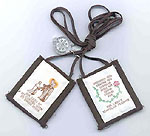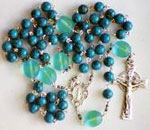Devotions to St. Jude.
Scapulars, novenas, rosaries, and holy cards.
Plaster saints.
 |
|
| Statue of St. Jude. Courtesy of Pacific Heritage Trading Co. |
Embarrassments to liberal Catholics, the stuff of nostalgia for conservatives, such artifacts and practices are largely relics of the past.
But just as young urban couples are furnishing homes with stuff their grandparents threw out at mid-century, so an enterprising group of younger scholars is finding rich resources in those religious relics. During the last decade or so, a spate of sophisticated studies by cultural historians--antique collectors of the spirit--have turned scholarly lenses to Catholicism, not as it was taught, but as it was lived. The locus of these cultural histories is urban immigrant homes, ethnic parishes and neighborhoods, and shrines.
Scholars engaged in the work say they have been influenced by academic trends in history and anthropology exported from Europe in the late 1970s. Historians had turned to history "from below," focusing more on everyday lives and popular fashion and less on military and political leaders and cataclysmic events.
"I can tell you when it was born," James Fisher said, speaking of the academic study of "lived religion," or popular religion, in the United States. "It started with publication of Robert Orsi's book 'Madonna of 115th Street' in 1985." Fisher holds the Danforth Chair in Theological Studies at St. Louis University.
Orsi's book, now a popular college text, describes and analyzes a yearly summer festa in Harlem when Italian-Americans lifted a Madonna from her niche over the altar at Our Lady of Mount Carmel Church and carried her in procession through neighborhood streets. Orsi, a strong storyteller and powerful writer, describes not only the pageantry of the festa but the complexity of the domestic, social, and economic lives of the people who orchestrated the festa and, during weeks of preparation, invested in it their prayers and hopes for help and healing.
"Every July 16, the soul of a people was revealed in East Harlem," Orsi wrote. "In the devotion to Mount Carmel, as it spilled out of the homes and into the streets of Italian Harlem, we are offered a unique opportunity to read the theology of a people."
The approach represented by Orsi's work, and increasingly by the work of others, represents a significant shift in the way Catholic history is done.
"Between the Second Vatican Council and the mid-1980s, the cutting edge of American Catholic intellectual life always focused on church reform and politics," Fisher said. "Then people began to discover the previous life of the church, especially the devotional life." Orsi's book "focused on people who hadn't been given a voice in the past. It showed how powerful their experience was. It inspired a lot of people to realize that these topics could be explored without fear."
Orsi has encountered hostility from people who mistakenly think he wants to revive bygone practices. "I'm a real liberal Catholic," he said. "My sympathies are all on that side. But I think these practices have been excessively trivialized by the Vatican II generation, treated with a mixture of humor and contempt." One reason for that, he said, is that most devotional practices are associated with women. "Catholic historiography has not been good to women," he said. "You can look at the major histories of American Catholics. The references to nuns are minimal. And yet nuns basically built the American church."
Fisher said Orsi's work was so successful, it inspired him and others, mostly Catholics doing graduate work at non-Catholic institutions, many of them now teaching at non-Catholic schools. But there's little sense among the people doing the work "of being alienated Catholics," Fisher said. Rather, "it's a very positive affirmation of something we see as very much a part of the church."
 |
|
| Scapular. Courtesy of Rose Scapular Co. |
"It's partly the hunger of memory," said Massa, who studied at Harvard and now directs American studies and chairs the undergraduate theology department at Fordham. "It's an attempt by students to figure out what they're about, what Grandma and Grandpa were about." The study of Catholicism, he said, "is breaking out of the theology-religious studies-history box, as interdisciplinary work comes into its own."
 |
|
| Holy Card Image of Our Lady of Lourdes |
"If you want to promote a shift in artistic taste" away from a particular style, "one way to do it is to call it feminine," she said.
McDannell said she is sympathetic to Catholics who mourn the loss of familiar objects in their churches. "Those radical changes are very hard for people, and most people had nothing to say about it," she said. "Imagine going to your mother's house and finding that she has thrown out all the stuff you were raised with, and she tells you that she's become a modernist. Many people invest a lot of psychological worth in material objects."
Orsi, leader of this doughty academic school, has also written "Thank You, St. Jude: Women's Devotion to the Patron Saint of Hopeless Causes" (1996), a social history of immigrants who turned to the saint as they struggled for a place in an often-alien world. In the years of Orsi's study, St. Jude, virtually unknown in the United States before the Depression, became one of the nation's most popular saints.
 |
|
| Rosary. Courtesy of Rosaries By Vivian |
Orsi realizes that some who have not read the new studies, and perhaps some who have, remain uncomfortable about such resurrections from the recent past. Whatever the reason--perhaps conflicts between contemporary Catholics on left and right--it's a stance Orsi regrets. "Ridiculing and mocking says a lot about where we are today in relation to our own past," he said.
"The Catholic contribution to America's popular culture is a huge story that's hardly been told," Fisher said. "If there's a political dimension to this, it's that everyone in the church has a voice that deserves to be heard."

